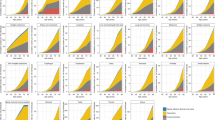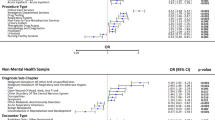Abstract
Purpose
Prior research suggested the increased likelihood of brain cancer diagnosis following certain psychiatric diagnoses. This association may result from detection bias or suggest an early sign for brain cancer. This study investigated whether psychiatric illness may be an early manifestation of brain cancer while considering potential effects of detection bias.
Methods
This case–control study used the data from the Department of Defense’s Central Cancer Registry and the Military Health System Data Repository. Four cancer-free controls and one negative-outcome control (cancers not associated with psychiatric illness) were matched to each brain cancer case diagnosed from 1998 to 2013 by age, sex, race, and military status. The groups were compared in the likelihood of having a pre-existing psychiatric diagnosis using conditional logistic regression.
Results
We found a significant association of psychiatric illnesses with brain cancer (Odds Ratio (OR) = 2.63, 95% confidence interval (CI) = 2.18–3.16) and other cancers (OR = 1.80, 95% CI = 1.49–2.19), compared to non-cancer controls. The association was stronger for psychiatric diagnoses within three months before cancer (brain cancer: OR = 26.77, 95% CI = 15.40–46.53; other cancers: OR = 4.12, 95% CI = 1.96–8.65). The association with psychiatric disorders within 3 months were higher for small brain tumors (OR = 128.32, 95% CI = 17.28–952.92 compared to non-cancer controls) while the OR was 2.79 for other cancers (95% CI = 0.86–8.99 compared to non-cancer controls).
Conclusion
Our findings suggest an association between diagnosed psychiatric illnesses and subsequent brain cancer diagnosis, which may not be solely explained by detection bias. Psychiatric illness might be a sign for early detection of brain cancer beyond the potential effects of detection bias.
Similar content being viewed by others
Data availability
The data from the Department of Defenses’ Central Cancer Registry (CCR) and the Military Health System Data Repository (MDR) cannot be shared publicly as they are third party data and do not belong to the authors. Interested researchers can contact the United States Department of Defense’s Joint Pathology Center (https://www.jpc.capmed.mil/educatino/dodccrs/researchers.asp) for CCR data and MDR access forms at https://www.health.mil/Military-Health-Topics/Technology/Support-Areas/MDR-M2-ICD-Functional-References-and-Specification-Documents.
References
Benros ME, Laursen TM, Dalton SO, Mortensen PB (2009) Psychiatric disorder as a first manifestation of cancer: a 10-year population-based study. Int J Cancer 124(12):2917–2922. https://doi.org/10.1002/ijc.24274
Carney CP, Woolson RF, Jones L, Noyes R Jr, Doebbeling BN (2004) Occurrence of cancer among people with mental health claims in an insured population. Psychosom Med 66(5):735–743. https://doi.org/10.1097/01.psy.0000133281.10749.64
Dalton SO, Mellemkjaer L, Olsen JH, Mortensen PB, Johansen C (2002) Depression and cancer risk: a register-based study of patients hospitalized with affective disorders, Denmark, 1969–1993. Am J Epidemiol 155(12):1088–1095. https://doi.org/10.1093/aje/155.12.1088
Dalton SO, Mellemkjaer L, Thomassen L, Mortensen PB, Johansen C (2005) Risk for cancer in a cohort of patients hospitalized for schizophrenia in Denmark, 1969–1993. Schizophr Res 75(2–3):315–324. https://doi.org/10.1016/j.schres.2004.11.009
Goldacre MJ, Wotton CJ, Yeates D, Seagroatt V, Flint J (2007) Cancer in people with depression or anxiety: record-linkage study. Soc Psych Psychiatr Epidemiol 42(9):683–689. https://doi.org/10.1007/s00127-007-0211-2
McGinty EE, Zhang Y, Guallar E, Ford DE, Steinwachs D, Dixon LB, Keating NL, Daumit GL (2012) Cancer incidence in a sample of Maryland residents with serious mental illness. Psychiatr Serv (Washington, DC) 63(7):714–717. https://doi.org/10.1176/appi.ps.201100169
Langston ME, Horn M, Khan S, Pakpahan R, Doering M, Dennis LK, Sutcliffe S (2019) A systematic review and meta-analysis of associations between clinical prostatitis and prostate cancer: new estimates accounting for detection bias. Cancer Epidemiol Biomarkers Prev 28(10):1594–1603. https://doi.org/10.1158/1055-9965.Epi-19-0387
Ostrom QT, Patil N, Cioffi G, Waite K, Kruchko C, Barnholtz-Sloan JS (2020) CBTRUS statistical report: primary brain and other central nervous system tumors diagnosed in the United States in 2013–2017. Neuro Oncol 22(12 Suppl 2):iv1–iv96. https://doi.org/10.1093/neuonc/noaa200
Lawrence D, Holman CD, Jablensky AV, Threlfall TJ, Fuller SA (2000) Excess cancer mortality in Western Australian psychiatric patients due to higher case fatality rates. Acta Psychiatr Scand 101(5):382–388. https://doi.org/10.1034/j.1600-0447.2000.101005382.x
Madhusoodanan S, Danan D, Moise D (2007) Psychiatric manifestations of brain tumors: diagnostic implications. Expert Rev Neurother 7(4):343–349. https://doi.org/10.1586/14737175.7.4.343
Madhusoodanan S, Opler MG, Moise D, Gordon J, Danan DM, Sinha A, Babu RP (2010) Brain tumor location and psychiatric symptoms: is there any association? A meta-analysis of published case studies. Expert Rev Neurother 10(10):1529–1536. https://doi.org/10.1586/ern.10.94
Nygaard C, Jensen H, Christensen J, Vedsted P (2018) Health care use before a diagnosis of primary intracranial tumor: a Danish nationwide register study. Clin Epidemiol 10:809–829. https://doi.org/10.2147/clep.S147865
Lu D, Andersson TM, Fall K, Hultman CM, Czene K, Valdimarsdottir U, Fang F (2016) Clinical diagnosis of mental disorders immediately before and after cancer diagnosis: a nationwide matched cohort study in Sweden. JAMA Oncol 2(9):1188–1196. https://doi.org/10.1001/jamaoncol.2016.0483
Ahrensberg JM, Fenger-Gron M, Vedsted P (2016) Primary care use before cancer diagnosis in adolescents and young adults—a nationwide register study. PLoS ONE 11(5):e0155933. https://doi.org/10.1371/journal.pone.0155933
Uher R, Treasure J (2005) Brain lesions and eating disorders. J Neurol Neurosurg Psychiatry 76(6):852–857. https://doi.org/10.1136/jnnp.2004.048819
Filley CM, Kleinschmidt-DeMasters BK (1995) Neurobehavioral presentations of brain neoplasms. West J Med 163(1):19–25
Keshavan MS, Kaneko Y (2013) Secondary psychoses: an update. World Psychiatry 12(1):4–15. https://doi.org/10.1002/wps.20001
Baillargeon J, Kuo YF, Lin YL, Raji MA, Singh A, Goodwin JS (2011) Effect of mental disorders on diagnosis, treatment, and survival of older adults with colon cancer. J Am Geriatr Soc 59(7):1268–1273. https://doi.org/10.1111/j.1532-5415.2011.03481.x
Dickey B, Normand SL, Weiss RD, Drake RE, Azeni H (2002) Medical morbidity, mental illness, and substance use disorders. Psychiatr Serv 53(7):861–867. https://doi.org/10.1176/appi.ps.53.7.861
Fiedorowicz JG, Palagummi NM, Forman-Hoffman VL, Miller DD, Haynes WG (2008) Elevated prevalence of obesity, metabolic syndrome, and cardiovascular risk factors in bipolar disorder. Ann Clin Psych 20(3):131–137. https://doi.org/10.1080/10401230802177722
Goldstein BI, Liu SM, Zivkovic N, Schaffer A, Chien LC, Blanco C (2011) The burden of obesity among adults with bipolar disorder in the United States. Bipolar Disord 13(4):387–395. https://doi.org/10.1111/j.1399-5618.2011.00932.x
Morden NE, Lai Z, Goodrich DE, MacKenzie T, McCarthy JF, Austin K, Welsh DE, Bartels S, Kilbourne AM (2012) Eight-year trends of cardiometabolic morbidity and mortality in patients with schizophrenia. Gen Hosp Psych 34(4):368–379. https://doi.org/10.1016/j.genhosppsych.2012.02.009
Regenold WT, Thapar RK, Marano C, Gavirneni S, Kondapavuluru PV (2002) Increased prevalence of type 2 diabetes mellitus among psychiatric inpatients with bipolar I affective and schizoaffective disorders independent of psychotropic drug use. J Affect Disord 70(1):19–26. https://doi.org/10.1016/s0165-0327(01)00456-6
Pearson WS, Dhingra SS, Strine TW, Liang YW, Berry JT, Mokdad AH (2009) Relationships between serious psychological distress and the use of health services in the United States: findings from the behavioral risk factor surveillance system. Int J Public Health 54(Suppl 1):23–29. https://doi.org/10.1007/s00038-009-0003-4
Rowan K, McAlpine DD, Blewett LA (2013) Access and cost barriers to mental health care, by insurance status, 1999–2010. Health Aff (Millwood) 32(10):1723–1730. https://doi.org/10.1377/hlthaff.2013.0133
Lawrence D, Kisely S (2010) Inequalities in healthcare provision for people with severe mental illness. J Psychopharmacol (Oxford, England) 24(4 Suppl):61–68. https://doi.org/10.1177/1359786810382058
Tanielian T, Farmer C (2019) The US military health system: promoting readiness and providing health care. Health Aff (Millwood) 38(8):1259–1267. https://doi.org/10.1377/hlthaff.2019.00239
Eyler AA (2012) Integrating behavioral health services within military health system: a model for opportunities and challenges. Transl Behav Med 2(3):262. https://doi.org/10.1007/s13142-012-0146-3
Department of Defense Joint Pathology Center (2014) DoD Cancer Registry Program. https://www.jpc.capmed.mil/education/dodccrs/index.asp (accessed 26 April 2019).
Defense Health Agency Military Health System Data Repository. https://www.health.mil/Military-Health-Topics/Technology/Clinical-Support/Military-Health-System-Data-Repository (accessed 26 April 2019).
North American Association of Central Cancer Registries (2018) Central Registry Standards. https://www.maaccr.prg.
Lipsitch M, Tchetgen Tchetgen E, Cohen T (2010) Negative controls: a tool for detecting confounding and bias in observational studies. Epidemiol 21(3):383–388. https://doi.org/10.1097/EDE.0b013e3181d61eeb
Dusetzina SB, Brookhart MA, Maciejewski ML (2015) Control outcomes and exposures for improving internal validity of nonrandomized studies. Health Serv Res 50(5):1432–1451. https://doi.org/10.1111/1475-6773.12279
Arnold BF, Ercumen A, Benjamin-Chung J, Colford JM Jr (2016) Brief report: negative controls to detect selection bias and measurement bias in epidemiologic studies. Epidemiol 27(5):637–641. https://doi.org/10.1097/ede.0000000000000504
Hegemann M (2018) Rare and changeable as a chameleon: paraneoplastic syndromes in renal cell carcinoma. World J Urol 36(6):849–854. https://doi.org/10.1007/s00345-018-2215-9
Qu Q (2014) Prognostic role and significance of paraneoplastic syndromes in hepatocellular carcinoma. Am Surg 80(2):191–196
Toro C (2010) Paraneoplastic syndromes in patients with oral cancer. Oral Oncol 46(1):14–18. https://doi.org/10.1016/j.oraloncology.2009.09.007
Kibbi N, Kluger H, Choi JN (2016) Melanoma: clinical presentations. Cancer Treat Res 167:107–129. https://doi.org/10.1007/978-3-319-22539-5_4
Kerkhof M, Benit C, Duran-Pena A, Vecht CJ (2015) Seizures in oligodendroglial tumors. CNS. Oncol 4(5):347–356. https://doi.org/10.2217/cns.15.29
Lin J, McGlynn KA, Carter CA, Nations JA, Anderson WF, Shriver CD, Zhu K (2016) The impact of preexisting mental health disorders on the diagnosis, treatment, and survival among lung cancer patients in the US military health system. Cancer Epidemiol Biomarkers Prev 25(12):1564–1571. https://doi.org/10.1158/1055-9965.Epi-16-0316
DeAngelis LM (2001) Brain tumors. N Engl J Med 344(2):114–123. https://doi.org/10.1056/nejm200101113440207
Charlson ME, Pompei P, Ales KL, MacKenzie CR (1987) A new method of classifying prognostic comorbidity in longitudinal studies: development and validation. J Chronic Dis 40(5):373–383. https://doi.org/10.1016/0021-9681(87)90171-8
Centers for Medicare & Medicaid Sevices (1987) CMS suppression policy. U.S. Department of Health & Human Services. https://www.hhs.gov/guidance/document/cms-cell-suppression-policy (accessed 24 May 2022)
Ehrenstein V, Kristensen NR, Monz BU, Clinch B, Kenwright A, Sørensen HT (2018) Oseltamivir in pregnancy and birth outcomes. BMC Infect Dis 18:519. https://doi.org/10.1186/s12879-018-3423-z
Jackson LA, Jackson ML, Nelson JC, Neuzil KM, Weiss NS (2006) Evidence of bias in estimates of influenza vaccine effectiveness in seniors. Int J Epidemiol 35(2):337–344. https://doi.org/10.1093/ije/dyi274
Lucia MS, Darke AK, Goodman PJ, La Rosa FG, Parnes HL, Ford LG, Coltman CA Jr, Thompson IM (2008) Pathologic characteristics of cancers detected in the prostate cancer prevention trial: implications for prostate cancer detection and chemoprevention. Cancer Prev Res (Phila) 1(3):167–173. https://doi.org/10.1158/1940-6207.Capr-08-0078
Hemminki K, Hemminki O, Forsti A, Sundquist K, Sundquist J, Li X (2017) Surveillance bias in cancer risk after unrelated medical conditions: example urolithiasis. Sci Rep 7(1):8073. https://doi.org/10.1038/s41598-017-08839-5
Miller EA, Pinsky PF, Pierre-Victor D (2018) The relationship between diabetes, prostate-specific antigen screening tests, and prostate cancer. Cancer Causes Control 29(10):907–914. https://doi.org/10.1007/s10552-018-1067-3
Tyrer P (2014) A comparison of DSM and ICD classifications of mental disorder. Adv Psychiatr Treat 20(4):280–285. https://doi.org/10.1192/apt.bp.113.011296
Frayne SM, Miller DR, Sharkansky EJ, Jackson VW, Wang F, Halanych JH, Berlowitz DR, Kader B, Rosen CS, Keane TM (2010) Using administrative data to identify mental illness: what approach is best? Am J Med Qual 25(1):42–50. https://doi.org/10.1177/1062860609346347
Kolodner K, Lipton RB, Lafata JE, Leotta C, Liberman JN, Chee E, Moon C (2004) Pharmacy and medical claims data identified migraine sufferers with high specificity but modest sensitivity. J Clin Epidemiol 57(9):962–972. https://doi.org/10.1016/j.jclinepi.2004.01.014
Acknowledgments
The contents of this publication are the sole responsibility of the authors and do not necessarily reflect the views, opinions, or policies of the Uniformed Services University of the Health Sciences (USUHS), The Henry M. Jackson Foundation for the Advancement of Military Medicine, Inc., the Department of Defense (DoD), or the Departments of the Army, Navy, or Air Force. Mention of trade names, commercial products, or organizations does not imply endorsement by the U.S. Government.
Funding
This project was supported by the Murtha Cancer Center Research Program, Department of Surgery, Uniformed Services University of the Health Sciences and Walter Reed National Military Medical Center under the auspices of the Henry M. Jackson Foundation for the Advancement of Military Medicine.
Author information
Authors and Affiliations
Contributions
All authors contributed towards the study design and analysis, interpretation of the results, and critical revisions of the manuscript. JAB conducted the statistical analysis and drafted the manuscript. KZ conceptualized and directed the study. CDS obtained funding.
Corresponding author
Ethics declarations
Conflict of interest
The authors declare that there are no completing interest.
Ethical approval
The use of the MilCanEpi data was approved by the institutional board of the Uniformed Services University of the Health Sciences.
Consent to participate
Patient consent was not required as data were not identifiable.
Additional information
Publisher's Note
Springer Nature remains neutral with regard to jurisdictional claims in published maps and institutional affiliations.
Supplementary Information
Below is the link to the electronic supplementary material.
Rights and permissions
About this article
Cite this article
Bytnar, J.A., Lin, J., Theeler, B.J. et al. The relationship between prior psychiatric diagnosis and brain cancer diagnosis in the U.S. military health system. Cancer Causes Control 33, 1135–1144 (2022). https://doi.org/10.1007/s10552-022-01608-4
Received:
Accepted:
Published:
Issue Date:
DOI: https://doi.org/10.1007/s10552-022-01608-4




